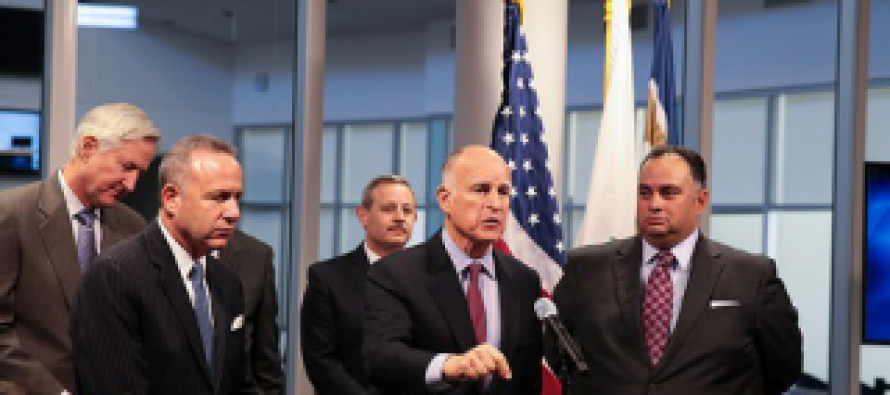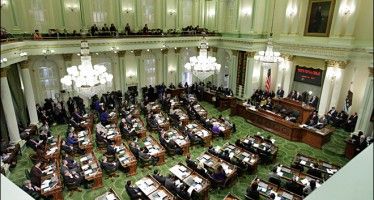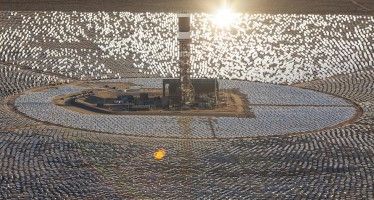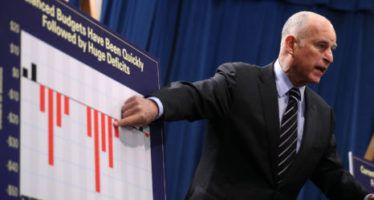Gov. Brown redefines ongoing programs as emergency drought aid

 Thirty-four days after California Gov. Jerry Brown declared an official statewide drought emergency, he joined State Senate President Pro Tem Darrell Steinberg and Assembly Speaker John A. Perez on Feb. 19 in announcing an emergency drought aid package. (They are pictured at right from the event.)
Thirty-four days after California Gov. Jerry Brown declared an official statewide drought emergency, he joined State Senate President Pro Tem Darrell Steinberg and Assembly Speaker John A. Perez on Feb. 19 in announcing an emergency drought aid package. (They are pictured at right from the event.)
Ninety five percent of the $687.4 million drought aid package, or $647.7 million, comes from the continuation of existing, ongoing programs, many of which began before an awareness of a protracted drought. The remaining 5 percent of the funding comes from shifting air pollution taxes collected in 2013 under the cap-and-trade air emission program toward water conservation and efficiency projects.
The governor’s drought package is the culmination of a bill, SB731, that Steinberg had been shepherding through the Legislature for some time.
As detailed in the table below, the $687.4 million emergency drought bill is funded from the following sources:
- $549 million, or 81 percent, from two existing water bonds, Proposition 84, the Safe Drinking Water Bond Act of 2006; and Proposition 1E, the Disaster Preparedness and Flood Protection Bond Act of 2006.
- $46.3 million, or 7 percent, from Federal Emergency Management Agency emergency food and shelter programs administered by the state.
- $40 million, or 5 percent, from shifting air pollution cap-and-trade taxes toward water conservation projects that also reduce air pollution.
- $20 million, or 2 percent, from shifting air pollution taxes mainly imposed in 2013 on refineries and electric power companies under California’s cap-and-trade emissions program.
- $15 million, or 2 percent, from Assembly Bill 21, the Safe Drinking Water and Small Community Emergency Grant Fund; and Assembly Bill 118, the Safe Drinking Water State Revolving Fund, both enacted on Oct. 8, 2013. The bills were enacted four months before the drought was declared. AB21 was introduced on Dec. 3, 2012 and AB118 on Jan. 4, 2013, more than a year before public officials became aware of a third consecutive year of low rainfall thus far into the 2014 rainy season.
- $13 million, or 2 percent, from wildfire brush clearance programs administered through the Department of Forestry and Fire Protection and the California Conservation Corps, with state general fund revenues.
- $10.4 million, or 1 percent, in unidentified funds in the governor’s press release toward unspecified projects.
Even though there is very little that is new in Brown’s drought bill, it will assure parched small water districts in Central California that funding is potentially available for relief efforts and projects.
Seventeen small water districts in California have been preliminarily identified as possibly running out of drinking water in the next two to four months. Two of these water districts in Mendocino and Sonoma counties along the Northern Coast are not even connected to the state or federal water projects.
Former Gov. Pete Wilson’s emergency policy
Brown suspended the California Environmental Quality Act in his official emergency drought declaration. But so far he hasn’t made steps to use that power to enlarge Shasta Dam or other projects.
By contrast, in 1994 after the Northridge earthquake, Gov. Pete Wilson invoked emergency powers to repair the Santa Monica freeway in four months.
Today, focus of the Democratic majority in both the governor’s office and the Legislature is to continue the course with mostly existing water conservation projects, not take emergency action through new construction.
Perpetual conservation or new water storage?
Nobody can predict all the impacts of this drought because no one knows its duration, even California’s expert climate change scientists.
Mike Wade of the California Farm Water Coalition reports that farmers spent $2 billion since 2003 on irrigation water conservation projects. Six water bonds from 2000 to 2011, Propositions 12, 13, 40, 50, 84, and 1E, totaling $19.55 billion, don’t seem to have produced much of a demonstrable result.
The total of the bond funding equates to 78 percent of the proposed, and much-criticized, $25 billion Delta Twin Tunnels project. So far, California hasn’t been getting much bang for its buck with conservation projects.
Brown, Steinberg and Perez’s emergency drought bill can’t make it rain. Legislatures and voter initiatives can fund more empty water bonds, but may only anger a public whose money has been taken for a water dousing rod that didn’t work.
Ultimately, Californians will have to vote on whether they want continual conservation policies that make for higher water rates, new reservoirs and tunnels to convey added system water — especially during droughts.
Breakdown of Gov. Brown’s Drought Aid Package
| Item | Amount | Percent Total | Source | Department | Status |
| Enhancing Water Conservation and Improving Water Supplies | $549 million | 81% | Prop. 84 and Prop. 1-E Water Bonds | Natural Resources Agency | Ongoing |
| Food Assistance | $25.3 million | 4% | State General Fund for admin. only;FEMA, Fed. Emergency Food Assistance Program | Calif. DPSS, Federal FEMA Food & Shelter Board | Ongoing |
| Drought related housing assistance | $21 million | 3% | State General Fund for admin.;FEMA | Calif. Dept. of Housing & Community Development; FEMA | Ongoing |
| Grants to agencies to improve water efficiency | $20 million | 3% | Greenhouse Gas Fund; air pollution taxes | Calif. Dept. of Water Resources | Fund shifting for Cal-Trans sprinkler systems |
| Emergency Drinking Water Fund | $15 million | 2% | AB 21 & AB 118(2013) | Calif. Dept. Public Health | Ongoing(2013) |
| Groundwater management | $14 million | 2% | AB 21 (2013) | Calif. Dept. of Public Health | Ongoing(2013) |
| Water use efficiency, reduce fire fuel sources | $13 million | 2% | General Fund | Dept. Forestry & Fire Protection; Calif. Conservation Corps | Ongoing wildfire brush clearance |
| Irrigation & water pumping systems that reduce air pollution | $10 million | 1% | Greenhouse Gas Fund; air pollution taxes | Cal. Dept. Food & Agriculture | Fund shifting |
| Water efficiency projects | $10 million | 1% | Greenhouse Gas Fund | Dept. Water Resources | Fund shifting |
| Unidentified | $10.1 million | 1% | Un-identified | Un-identified | Unknown |
| Total | $687.4 million | 100% | See above | See above | See above |
| Note: Numbers from governor’s office don’t add up. See here. | |||||
Related Articles
June ballot measure “orphaned,” but poised to pass
While dozens of measures are vying to make it on the November general election ballot, one proposal is ready for the June primary
Ivanpah solar power shifts pollution to the desert
This is Part 1 of a two-part series on Ivanpah solar power. It’s supposed to be the latest thing in solar
Is California budget as ‘balanced and progressive’ as Gov. Brown suggests?
SACRAMENTO – The California Assembly and Senate have until Thursday to approve the budget deal announced by Gov. Jerry Brown




